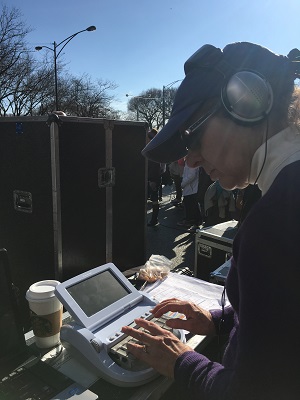Are rallies in the United States accessible?
by Beth
I am pleased to introduce Rachel Arfa, a disability rights attorney, as a guest blogger today. In her spare time, Rachel advocates for cultural accessibility, an area she is passionate about. Rachel is profoundly deaf, communicates by talking and lipreading and uses bilateral cochlear implants to hear. She is on the steering committee of the Chicago Cultural Accessibility Consortium and serves on the Board of Directors of 3Arts. She is a 2016 Fellow of Leadership Greater Chicago, and a 2017 Fellow in the Illinois Women’s Institute for Leadership (IWIL), which trains Democratic women to run for office.
by Rachel Arfa

Many volunteers helped make the Women’s March in Chicago accessible.
10,000.
10,000 people.
The number seemed daunting. We had just committed to providing accessibility for an event where the number of attendees might be as high as 10,000. Christena Gunther. Evan Hatfield. Risa Rifkind. Anna Cosner. We’d worked together on various cultural accessibility initiatives before, but never on this scale.
But we knew it would be worth it.
The details: Petrillo Stage in Grant Park, Saturday, January 21, 2017. The five of us met weeks ahead of the march to put together a plan to make the rally portion accessible. We wrote access information for the Women’s March website, conducted a site visit to scope out all the access points and determined placement for all the accessibility needs.
One week before the March, the location of the rally was changed.
We scuttled our initial plans, visited the new site at Jackson and Lake Shore Drive and re-assessed what would work.
And then the number of projected attendees grew from 10,000 to 22,000. This was getting big!
And then, the site changed again. Two days before the Saturday March, the location was moved to its final site, Jackson and Columbus. Weather reports were coming in, temperatures in Chicago were predicted to be well above average Saturday, and the final estimate of marchers was projected at anywhere from 50,000 to 65,000.
We met at the site the night before the march to walk through our plan and update the website about accessibility offerings – we wanted marchers with disabilities to know where to find accessibility tents if they needed more information once they arrived.
We were back at the site less than 12 hours later, at 6:30 a.m., to get ready for attendees to arrive. We’d recruited enthusiastic volunteers from Chicago’s theaters, museums and outdoor spaces – all had experience in working to make their own organizations welcoming and accessible to audiences with disabilities.

Rachel and her friends are in there!
One accessibility tent was set up at the entrance to the rally, and the one near the stage was where attendees could check out audio description headsets and assistive listening devices. The audio describer set up her equipment in a spot with full view of the stage, armed with her stenographer’s mask. The American Sign Language (ASL) interpreters decided on their stage set-up. The screen for Open Captioning was placed on stage at optimal height for viewing. The chairs set up to provide seating for those unable to stand for extended periods of time were moveable, which created easy access for attendees using a wheelchair or mobility device. A DeafBlind participant was provided enough space for tactile interpreting to have access to what was happening on stage. Individuals who experience anxiety or PTSD had enough space to move around and not feel claustrophobic. And, oh yes. An easy route to the accessible port-a-potties was established as well.
The morning sped by as attendees arrived, but when I found the time, I reached out to some of them to ask if they’d be willing to let us know what their experience was like. Here are just three excerpts of many, many testimonials:
- Bryen Yunashko: This was the first time that I, as a DeafBlind person, was able to fully access a political rally in Chicago. The efforts and constant dialogue by the accessibility team in the weeks following up to the March to ensure DeafBlind access was amazing, conscientious, dedicated and authentic. This event is a shining example for all future events in Chicago and elsewhere.
- Aziza Nassar: The volunteers and staffers were very accommodating and culturally appropriate. Within seconds of my arrival to the gate, I was greeted by a woman who asked me and my friend (who is also a wheelchair user) whether we needed “dedicated assistance.” She pointed us in the direction of a tent full of volunteers just ready to assist, and another woman walked us down to the accessible viewing area for the rally stage pointing to the wheelchair accessible Port-a-Pottys.
- Justin Cooper I knew that many of my friends would be in attendance and I wanted to be there to show my support. The accessibility that was provided made me feel like I was welcomed, that I was apart of the March, and that people with disabilities (especially women with disabilities) were included. I give credit to all the volunteers who helped.
These efforts were successful because disability access was integrated into the design of the event, including each time the venue changed. The March organizers recognized early on the need for disability access and supported our efforts after we’d come on board.
During the March it was announced not that there were 10,000 in attendance, not 22,000 in attendance, or even 50,000 in attendance. It was announced at an early point that there were 150,000 attendees. Then, a second announcement came saying there were 250,000 attendees. The march was a huge success, and we’d designed accessibility that was easily adaptable to the scale needed.
250,000 people.
250,000 strong.
250,000.






